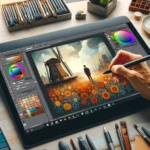Ever wondered what it’s like to go behind Photoshop? This article reveals the inner workings of Adobe Photoshop, offering insights into how users interact with the software on a deeper level. Ready to discover the power of Photoshop beyond the surface?
Adobe Photoshop is widely regarded as the premier tool for graphic design, photo editing, and digital art creation. However, there’s a lot more to Photoshop than meets the eye. The powerful software allows users to delve deeper into the creative process, exploring its features and shortcuts that aren’t immediately visible. In this article, we will take you on a journey behind Photoshop, revealing the technical side of the software, its hidden features, and how to maximize its potential.
1. Once Behind Photoshop: Discovering the Hidden Features
When you first open Adobe Photoshop, the interface might seem intimidating, especially for beginners. But once you understand the ins and outs of the program, you’ll quickly realize that there’s much more beneath the surface.
Here are five key features that many users overlook:
-
Smart Objects These are layers that preserve an image’s source content, allowing for non-destructive editing.
-
Adjustment Layers These provide a flexible way to adjust colors, brightness, contrast, and more without permanently altering the image.
-
Layer Masks Using these, you can hide parts of a layer or reveal them in a non-destructive manner.
-
Actions Photoshop allows you to record a series of steps to automate repetitive tasks.
-
Content-Aware Fill A feature that intelligently fills in missing or damaged parts of an image by analyzing surrounding pixels.
These features go beyond the basic tools like the brush, eraser, or crop tool, offering more advanced options for experienced users. For example, Smart Objects are incredibly useful for those who want to work non-destructively, meaning any edits can be reversed or modified at any time.
Going behind Photoshop involves learning how to use these hidden gems to your advantage. As you explore, you will be able to perform more complex edits, automate workflows, and significantly improve your efficiency.
Learn More About Photoshop Features 👉
2. Going Behind Photoshop: Understanding the Software’s Structure
When you truly “go behind Photoshop,” you start to understand how the software is built. Behind the intuitive interface is a powerful system of layers, adjustments, and commands that work in tandem to give users creative freedom.
Key structural elements include:
-
The Layer System Photoshop’s layers are the foundation of non-destructive editing. Layers allow you to separate different elements of your image, making edits without permanently affecting the original content.
-
Blend Modes These determine how layers interact with each other, enabling effects like shadows, highlights, or various blending options.
-
Shortcuts and Workflow A deep understanding of keyboard shortcuts can significantly enhance your productivity. For instance, using “Ctrl+T” for free transform or “Ctrl+Shift+N” for creating a new layer speeds up editing processes.
-
Workspace Customization Photoshop allows you to customize your workspace to fit your editing style. Whether you’re working on photo retouching or graphic design, setting up a workspace that suits your needs can make a big difference in efficiency.
-
Advanced Selections and Masking Understanding how to use advanced selection tools like the Pen Tool, Magic Wand, or Lasso Tool opens up the possibility for precise editing.
While many users start with the basic editing tools, advanced users take full advantage of these features. Understanding the relationship between layers, blending modes, and selections helps professionals create complex compositions, seamless images, and polished designs.
Explore Photoshop’s Workflow 👉
3. Going Back to Photoshop: The Power of Resetting and Customizing Your Experience
Sometimes, after exploring the depths of Photoshop, you might feel overwhelmed by all the options and customizations available. This is where the option to “go back” or reset your workspace can be incredibly useful. Whether you accidentally changed a setting or just want to refresh your environment, Photoshop offers ways to reset your workspace, shortcuts, and preferences.
Here are a few tips to reset and customize your Photoshop experience:
-
Resetting Preferences Photoshop allows you to reset your preferences to default by holding “Ctrl+Alt+Shift” while launching the program. This restores the software to its original settings.
-
Shortcuts Customization You can modify keyboard shortcuts for frequently used actions. This saves time and streamlines your editing process.
-
Workspace Reset If you’ve customized your workspace but feel that it’s not working for you anymore, Photoshop makes it easy to reset the workspace to its default setup.
-
Creating Presets For specific editing needs, you can create and save presets for things like color corrections, styles, or brushes.
-
Plugin Management Installing and organizing plugins can enhance your workflow, but it’s important to know how to manage and uninstall them if they’re not adding value.
Customizing and resetting your Photoshop environment ensures you work in a way that best suits your needs. Whether you’re a beginner or an expert, these tools allow you to stay organized and efficient.
Discover Photoshop Shortcuts 👉
Conclusion
In conclusion, going behind Photoshop is all about understanding its deeper features and structure. Whether you’re working with layers, adjusting shortcuts, or customizing your workspace, exploring these hidden aspects of Photoshop will help you unlock its full potential. As you continue to use the software, remember that going beyond the surface can take your creativity to new heights.
As famous graphic designer David Carson once said, “Graphic design will save the world right after rock and roll does.” With Photoshop as your tool, the possibilities are endless.






